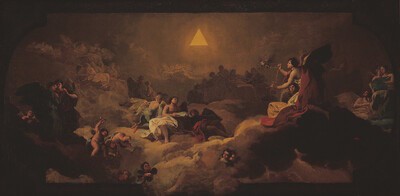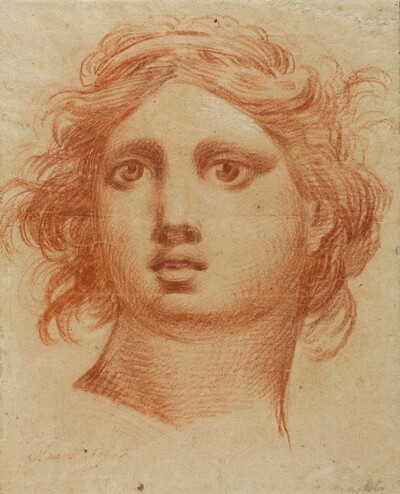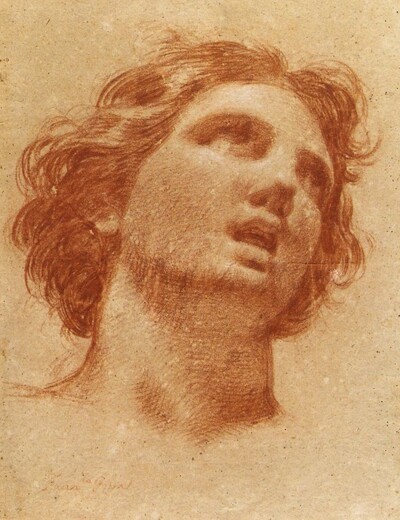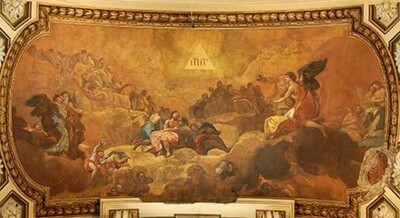- Cronología
- Ca. 1772
- Ubicación
- The Prado National Museum. Madrid, Madrid, Spain
- Dimensiones
- 451 x 350 mm
- Técnica y soporte
- Reconocimiento de la autoría de Goya
- Documented work
- Titular
- El Prado National Museum
- Ficha: realización/revisión
- 04 Oct 2021 / 15 Jun 2023
- Inventario
- D4394
Franco Goya (bottom left-hand corner)
Javier Goya, Madrid, 1828; Mariano Goya, Madrid, 1854; Valentín Carderera, Madrid, c. 1861; Mariano Carderera, Madrid, 1880; Prado Museum, 1886.
This is one of the three known preparatory drawings of heads of angels with young men for the vault of the choir stalls in the Basílica del Pilar in Saragossa, which Goya painted in fresco in 1772 on the theme of the Adoration of the Name of God. The other two drawings are in the Zaragoza Museum and the Louvre. With this commission he demonstrated his ability to produce a large-scale composition, his first public work and one for a singularly emblematic place in the city.
The changes between the preparatory sketch and the final fresco, as well as their comparison with the three drawings, show that Goya studied the work carefully.
There are some discrepancies as to which of the various angels in the fresco corresponds to each of the three drawings, if one can speak of a direct correspondence. This one in particular is related to the standing angel on the left of the composition.
The way in which they are drawn corresponds to a prototype of ideal classicist beauty that Goya had contemplated during his stay in Italy, using parallel and crossed strokes to achieve the shading on the face. Occasionally he darkens the area around the eyes as a more expressive device.
-
El arte de GoyaMuseo de Arte Occidental de TokioTokyo1971from 16th 1971 to January 23th 1972. Exhibited also at the Kyoto Municipal Museum of Art, January 29th to March 15th 1972.cat. 209
-
Goya. Das Zeitalter der Revolucionen. Kunst um 1800 (1980 – 1981)Hamburger KunsthalleHamburg1980cat. 209
-
Goya y Zaragoza (1746-1775). Sus raíces aragonesasMuseo Goya. Colección IbercajaZaragoza2015cat. 9
-
Santander2017
-
Madrid2019cat. 3
-
Goya: etude biographique et critique suivié des catalogues completsParísLibrarie de l'Art Ancien et Moderne1902p. 11
-
MadridMuseo del Prado1954p. 450
-
Madrid1965pp. 19-23
-
Vie et ouvre de Francisco de GoyaParísOffice du livre1970pp. 82, cat. 32
-
BarcelonaPolígrafa1970t. I, pp. 239, cat. 25
-
Dibujos de Goya, 2 volsBarcelonaNoguer1975pp. 26-27, cat. 1
-
El mundo de Goya en sus dibujosMadridUrbión1979p. 32
-
Goya, Das Zeitalter de Revolutionen. 1789-1830HamburgPrestel-Verlag Münche und Hamburger Kunsthalle1980p. 256
-
ZaragozaCaja de Ahorros de Zaragoza, Aragón y Rioja1980-1982vol. I, p. 55
-
Goya. El capricho y la invención. Cuadros de gabinete, bocetos y miniaturasMadridMuseo del Prado1993p. 106-108
-
Goya y Aragón. Familia, amistades y encargos artísticoscol. Col. Mariano de Pano y RuataZaragozaCaja de Ahorros de la Inmaculada de Aragón1995p. 89-92
-
Goya y Zaragoza (1746-1775). Sus raíces aragonesasZaragozaFundación Goya en Aragón, Ibercaja y Gobierno de Aragón2015pp. 123-124 cat. 9
-
SantanderFundación Botín y Museo Nacional del Prado2017pp. 31
-
SantanderFundación Botín y Museo Nacional del Prado2018pp. 319-321 cat. 29
-
MadridMuseo Nacional del Prado2019pp. 56 cat. 3




